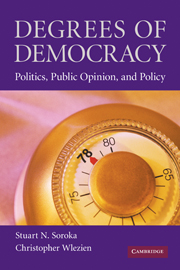Book contents
- Frontmatter
- Contents
- Preface
- Degrees of Democracy
- 1 Public Opinion and Policy in Representative Democracy
- 2 The Thermostatic Model
- 3 Adding Issues and Institutions
- 4 Public Preferences and Spending
- 5 Parameters of Public Responsiveness
- 6 Public Responsiveness Explored
- 7 Policy Representation
- 8 Disaggregating Public Responsiveness and Policy Representation
- 9 Degrees of Democracy
- Appendix
- Bibliography
- Index
5 - Parameters of Public Responsiveness
Published online by Cambridge University Press: 05 June 2012
- Frontmatter
- Contents
- Preface
- Degrees of Democracy
- 1 Public Opinion and Policy in Representative Democracy
- 2 The Thermostatic Model
- 3 Adding Issues and Institutions
- 4 Public Preferences and Spending
- 5 Parameters of Public Responsiveness
- 6 Public Responsiveness Explored
- 7 Policy Representation
- 8 Disaggregating Public Responsiveness and Policy Representation
- 9 Degrees of Democracy
- Appendix
- Bibliography
- Index
Summary
Preceding chapters have set out the theory behind the thermostatic model, and our expectations of how public feedback and policy representation will vary across domains and political institutions. This is the first of four chapters that test these hypotheses.
We begin by looking at public responsiveness to policy change – the “feedback” critical to a functioning democracy. Across the next few chapters, our analyses proceed in four stages, corresponding roughly to these questions: (1) Does the public respond to policy change? (2) To what do they respond? (3) When do they respond? and (4) Who responds? The first question is of course relatively clear – we want to know whether the thermostatic model works, whether policy feeds back (negatively) on public opinion. The subsequent questions probe the issue of public responsiveness. In Chapter 6, we explore the difference in feedback to legislative action (appropriations) versus actual spending (outlays); we also examine there the timing of responsiveness – the point in the fiscal year when the public learns about changes in policy. We examine responsiveness further still in Chapter 8, which considers whether certain groups respond more than others.
We first want to know, Does the public respond? The chapter begins with a brief review of our model of public responsiveness. We then present models of defense spending alongside combined social spending, first in the United States and then across our three countries. These models set the stage for subsequent analyses.
- Type
- Chapter
- Information
- Degrees of DemocracyPolitics, Public Opinion, and Policy, pp. 88 - 106Publisher: Cambridge University PressPrint publication year: 2009

